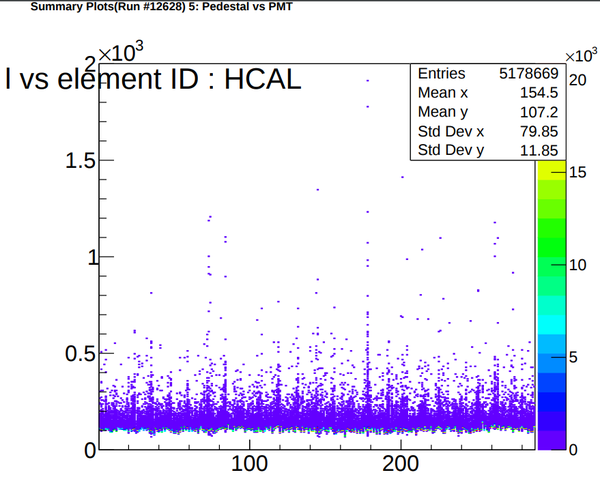Checking 50k Plots
<<SBS Main<< HOW TOs (BigBite Spectrometer)
This page describes what to look for when evaluating the 50k replay plots to check HCal's performance.
Contents
Where to Find HCal 50k Plots
After each production run a replay of the raw data on 50k events will be performed and the results posted to the HALOG under the title '50k replay plots for run XXXXX'. In this log entry will be an attachment called 'summaryPlots_12628_hcal_50k.pdf' which contains the plots described here.
What to Look for in HCal 50k Plots
This section will describe the plots for the HCal 50k replay and what one should look for when checking them. Note that sometimes plots are added or removed from this output so each plot may not always be exactly where described here.
Summary Plots Page 1
The top left plot labeled 'Cluster ADC time over all channels : HCAL' shows the fADC times of the clusters found in HCal (an energy cut is applied). The fADC window is currently 160 ns. The events coincident in HCal and BBCal are calibrated to occur in the fADC window at about 60 ns. There should be a Gaussian beginning to form aroun 60 ns. If this structure is missing there may have been a trigger time or latency change that the experts need to address.
The top right plot labeled 'Amplitude vs Module (saturation check): HCAL' shows the a spectrum of all the fADC waveform amplitudes (in mV) vs. the PMT module number (from 1 to 288). The fADCs for HCal use a 2V range. Signals above 2V indicate that the module saturated for an event. Saturated events are generally set by the analysis code to list their values at about 4V, so one will see a small band of saturated hits at 4V. It is expected to see the fADCs saturate occasionally, but the bulk of the data should be below saturation. This becomes an issue if any channels are saturating very frequently. Experts may need to adjust the PMT module HVs in these channels or otherwise address the issue.
The bottom left plot labeled 'ADC amp vs int : HCAL' shows the correlation of fADC waveform amplitudes for each PMT module vs the fADC waveform integral per module per event. The fADC amplitude should be correlated roughly linearly with the fADC integral, so you should see a generally linear correlation on the 2D plot. This is another way to check for saturation issues or other anomalies.
The bottom right plot labeled 'ADC amplitude vs module ZOOM : HCAL' is the same as the top right plot except it is zoomed in on the Y-axis. One should see a roughly even distribution of fADC amplitudes between all 288 PMT modules, with more of the events near 0 mV (the fADC pedestal). There may be some variance due to geometry and HV settings, but no channel should have events only at a value of 0 mV. This would indicate that PMT has a bad connection or lost HV.







